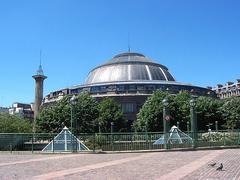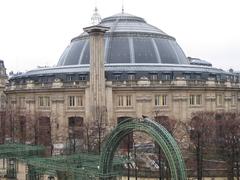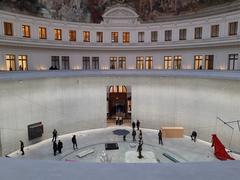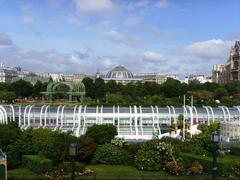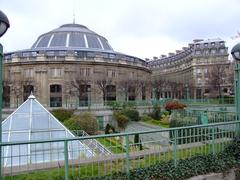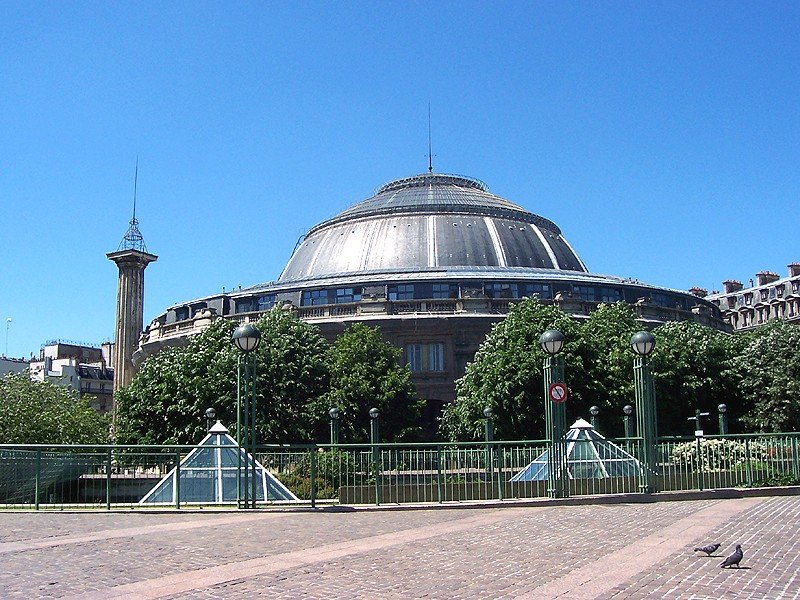
Bourse de Commerce Paris: Visiting Hours, Tickets, and Historical Significance
Date: 14/06/2025
Introduction
Nestled in the heart of Paris, the Bourse de Commerce – Pinault Collection stands as a symbol of the city’s ability to harmoniously blend its layered history, architectural ingenuity, and vibrant cultural scene. Once a medieval noble residence, later an 18th-century grain exchange, and eventually a 19th-century stock exchange, the building’s journey culminates today as a premier contemporary art museum (museos.com; francechannel.tv). The Bourse de Commerce is a must-visit for those seeking to explore Paris historical sites, architectural heritage, or contemporary art. This comprehensive guide covers its rich history, architectural highlights, practical visitor information—including Bourse de Commerce visiting hours and tickets—as well as tips for making the most of your experience.
Historical Overview
Medieval and Renaissance Origins
The story of the Bourse de Commerce begins in the medieval period, when a grand townhouse occupied the site, serving as a residence for Parisian nobility. In the 16th century, Catherine de’ Medici acquired the property. She commissioned the now-iconic 31-meter Medici column in 1578, reputedly used as an observation platform for astrologers, reflecting the Renaissance fascination with astronomy (museos.com; francechannel.tv). After passing through several owners, the original building was demolished in 1748, leaving only the Medici column as a vestige of its Renaissance past.
The 18th-Century Grain Exchange
Between 1763 and 1767, the site was transformed into the Halle au Blé (grain exchange), a circular building constructed around the Medici column. This innovative design featured upper-floor storage and galleries for merchants. Originally covered by a wooden dome (destroyed by fire in 1802), it was replaced in 1812 by a pioneering glazed dome, supported by a cast iron structure—one of France’s earliest examples of such engineering (wikipedia; archdaily.com).
19th-Century Evolution: From Grain to Commerce
After a fire in 1854 and a period of disuse, the building was repurposed as the Bourse de Commerce in 1885. Architect Henri Blondel redesigned the main entrance and added a monumental Beaux-Arts façade. The rotunda’s interior was adorned with a panoramic fresco by several artists, depicting the global history of trade (museos.com). The building was inaugurated during the 1889 Exposition Universelle, the same year as the Eiffel Tower’s debut.
20th-Century Adaptations and Preservation
Throughout the 20th century, the Bourse de Commerce continued as a commodities trading hub. It was transferred to the Paris Chamber of Commerce in 1949 and classified as a historical monument in 1975. Restoration efforts in the late 20th century preserved its dome and murals (wikipedia; cyrilzammit.com).
Architectural Highlights
The Bourse de Commerce is a unique synthesis of eras: the Medici column, the 18th-century circular plan, the 19th-century cast iron and glass dome, and the Beaux-Arts entrance. The dome, measuring approximately 35 meters in diameter, is a landmark of early industrial engineering. Inside, the rotunda’s 140-meter-long panoramic fresco, which encircles the space, is a rare specimen of monumental 19th-century art (archdaily.com; pinaultcollection.com). The building also retains industrial features such as its original cooling system in the Salle des Machines (cyrilzammit.com).
Transformation into a Contemporary Art Museum
In 2016, the City of Paris leased the building to art collector François Pinault, founder of the Pinault Collection. Renowned architect Tadao Ando led its transformation, completed in 2020. Ando introduced a striking 30-meter-diameter, 9-meter-high concrete cylinder within the rotunda, creating a powerful dialogue between heritage and modernity (pinaultcollection.com; archdaily.com). The design preserves the dome, frescoes, and Medici column, while adding new exhibition spaces, an auditorium, and a panoramic restaurant.
Visitor Information: Tickets, Hours & Tips
Visiting Hours
- Tuesday to Sunday: 11:00 am – 7:00 pm
- Fridays: Late opening until 9:00 pm
- Closed: Mondays and May 1st
- Free Admission: First Saturday of every month, 5:00 pm – 9:00 pm (This is Paris Blog)
Tickets and Prices
- General Admission: €15; includes access to all exhibitions and the audio guide app in six languages (This is Paris Blog)
- Discounted Rates: Available for students, young people, and other eligible groups; check the official ticketing page for details
- Free Entry: Visitors under 18, and all during the first Saturday late opening
Tip: Advance online booking is recommended to avoid queues.
Accessibility
The museum is fully wheelchair accessible with step-free entrances and elevators to all floors. Dedicated seating in the auditorium and accessible restrooms are available. The audio guide app is accessible in multiple languages, and visitors with special needs can contact the accessibility team in advance (Pinault Collection Events).
Facilities and Services
- Cloakroom: Available for coats and small bags
- Restrooms: Accessible facilities provided
- Wi-Fi: Free throughout the museum
- Restaurant: La Halle aux Grains, offering French cuisine and city views (This is Paris Blog)
- Museum Shop: Books, catalogs, and design objects
Duration of Visit
Most visitors spend 1–2 hours, but art and architecture enthusiasts may wish to stay longer (This is Paris Blog).
Getting There
- Address: 2 Rue de Viarmes, 75001 Paris
- Metro: Les Halles (Line 4), Louvre-Rivoli (Line 1), Châtelet (Lines 1, 4, 7, 11, 14)
- RER: Châtelet–Les Halles (Lines A, B, D)
- Bus: Multiple lines serve the area
- Parking: Forum des Halles parking garage nearby (Pinault Collection)
Practical Tips
- Book tickets online to skip queues, especially on weekends and during exhibitions
- Visit on weekdays or during late openings for a quieter experience
- Combine your visit with nearby sites: Louvre, Centre Pompidou, Jardin du Palais Royal
- Use the audio guide app for enriching insights; bring headphones
- Non-flash photography is permitted in most areas; check for restrictions
- Wear comfortable shoes for exploring the rotunda and exhibition halls
- Reserve dining at La Halle aux Grains in advance for weekends
- Consider a Paris Museum Pass for multiple museums (This is Paris Blog)
Current and Upcoming Exhibitions
As of June 2025, the Bourse de Commerce is hosting:
- Corps et Âmes (through August 25, 2025): Exploring body and soul in contemporary art (Paris Update)
- Arthur Jafa (through August 25, 2025): Solo exhibition by the American artist
- Ali Cherri (through August 25, 2025): Recent works by the Lebanese artist
- Céleste Boursier-Mougenot (through September 21, 2025): Immersive sound installation
See the official website for the latest schedule.
Events and Special Programs
The museum regularly hosts talks, performances, guided tours, and workshops, often free with reservation. For example, June 2025 events include lectures on art and music, plus screenings like Jean Cocteau’s “Le Sang d’un poète” (Pinault Collection Events).
Visuals and Media
High-quality images, virtual tours, and interactive maps are available on the official website, allowing visitors to preview the site’s architecture and exhibitions.
Highlights for Visitors
- The 35-meter-diameter glass dome and panoramic mural in the rotunda
- Tadao Ando’s minimalist concrete cylinder, creating a dramatic visual dialogue
- Proximity to the Louvre, Centre Pompidou, and Palais Royal
- Contemporary art from the renowned Pinault Collection
- On-site dining with city views at La Halle aux Grains
Frequently Asked Questions (FAQ)
What are the Bourse de Commerce opening hours?
Tuesday to Sunday, 11:00 am – 7:00 pm; Friday until 9:00 pm; closed Mondays and May 1st.
How do I buy tickets?
Purchase online via the official ticketing page; on-site purchase is also possible.
Is the museum wheelchair accessible?
Yes, with step-free access, elevators, accessible restrooms, and reserved seating in the auditorium.
Are photos allowed?
Non-flash photography is generally permitted; check signage for restrictions.
Is there a restaurant?
Yes, La Halle aux Grains offers contemporary French cuisine with city views.
Summary and Visitor Recommendations
The Bourse de Commerce is a living narrative of Paris’s transformation, from its medieval origins and economic role to its present-day cultural significance. Its innovative architecture—blending the Medici column, circular plan, cast-iron and glass dome, and Tadao Ando’s contemporary intervention—offers a unique spatial and artistic experience (archdaily.com; pinaultcollection.com). With regularly changing exhibitions, accessible facilities, and a central location, the museum invites visitors to immerse themselves in the evolving story of Paris.
Plan ahead: Consult up-to-date Bourse de Commerce visiting hours and ticketing options, leverage guided tours and special events, and download the audio guide app for a richer experience. For continuous updates and insider tips, download the Audiala app and follow related cultural platforms.
Sources and Further Reading
- Museos: Bourse de Commerce Paris
- France Channel TV: The Story Behind the Bourse de Commerce
- ArchDaily: La Bourse de Commerce – Tadao Ando Architect and Associates
- Pinault Collection: Three Years of Transformation at Bourse de Commerce
- Paris Insiders Guide: Bourse de Commerce Paris Insider Guide
- This is Paris Blog: Visiting the Bourse de Commerce in Paris
- The Geographical Cure: Guide to the Bourse de Commerce
- Paris La Douce: Bourse de Commerce – Architectural Significance
- Paris Update: Upcoming Exhibitions
- Pinault Collection: Events
- The Better Vacation: Bourse de Commerce
